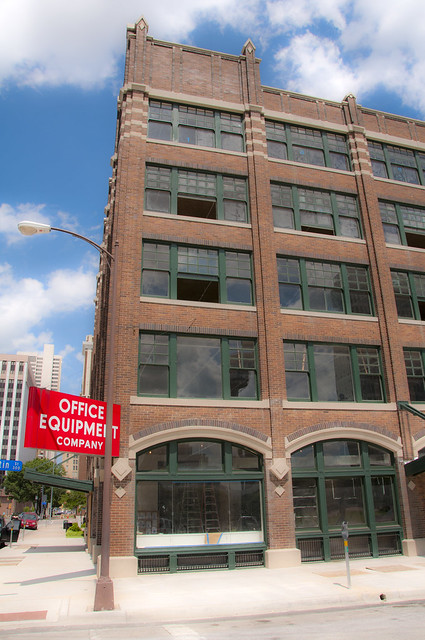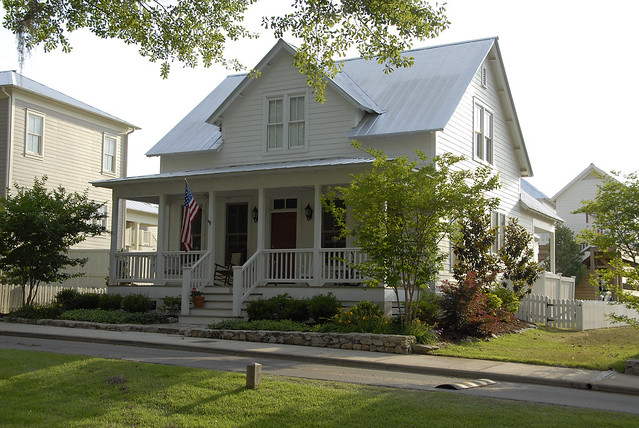Residential maturing
One thing I did not clearly state on Monday (Why decline is not normal) was how the "maturing" process is capable of happening in the traditional development pattern, but not in the suburban pattern. The traditional grid and all its variations is an amazing platform for different intensities of development. In comparison, when you build a strip mall on a frontage road, there is no natural progression for that building other than decline. When you build a traditional neighborhood, an entire palette of possibilities is available.
Before I go any further, I need to let you know that the images in today's post are from the library of Steve Mouzon, one of the people I most admire in CNU. If asked to sit down and write out a list of people I'd like to have over for dinner, Steve would be high on that list. But you should know that his amazing library of photos is not something reserved for his pals and acquaintances (and those that pester him, like me). All of these photos and more are available online for purchase at a ridiculously low price. I sometimes just go there to browse when looking to complete a thought visually. Check it out.
So how does a residential neighborhood mature? It is simple. Over time, as value is added to a neighborhood, natural market forces put pressure on properties to expand, redevelop and intensify. This is not coercion and it is not something that needs to be subsidized. When done in a healthy neighborhood, the progression is incremental, smooth and welcome. This stands in stark contrast to our current approach, which is often a random effort, completely out of scale and resisted by the neighborhood.
So a traditional neighborhood is established. The first natural iteration would be the single family home. Now being from Steve's library, this is a very nice home. It doesn't have to be this big or this nice. A small single family would be just fine in most infant neighborhoods.
As value is added to the neighborhood, the underlying land value will increase. Once so much value is amassed (let's say, for example, because it is within a couple of blocks of a great downtown or a block from a transit stop), there will be a natural demand for redevelopment. From a mathematical standpoint, when the improvements on the lot are less than 3x the value of the land, there should naturally be redevelopment pressure.
As an example, if you have a lot worth $50,000, a stable investment is a home worth at least $150,000 for a total lot value of not less than $200,000. Let's say that the house remains static but the land becomes worth $100,000. There will be natural market pressure to improve the structure -- either through an addition or some type of redevelopment -- to be worth at least $300,000. This would give a stable value of $400,000.
Now understand that the pressure is not on the homeowner, per se. Your property doesn't go up $10,000 and you suddenly feel the pressure to spend $30,000 on granite counters and new flooring. But as properties change hands and the market turns over -- which is an incremental process that happens slowly over time -- the people buying the lot will take this into account. The further the property is below that 3:1 ratio, the higher percentage of developers that will be interested in it (assuming it is a healthy neighborhood with appreciating property values).
What will a developer then do with it? In a healthy neighborhood, that developer might be the person next door. Or it could be someone from out of town. Either way, the lot is not going to have increased in value enough to support a high rise apartment (which wouldn't fit in the neighborhood anyway). But a duplex would be just fine. It is a small incremental change, allows the property owner to get more value out of it (could perhaps be half owner occupied and half rented) and is compatible with the adjacent neighborhood.
Nobody reasonable is going to be offended by that house popping up amongst a bunch of single family residences. And if it is simply an expansion of an existing home to create a duplex, nobody is going to mind that either. This is a great neighborhood and everything is working well.
But let's say that even more value is added. Not only do you have a great downtown and a transit stop, but you now have a great park and a lot of cultural activities going on in and around this spot. Not only that, but the downtown is growing too, some really chic retail has crept in to some formerly-residential spots up the block and the transit line has been connected to a major hub. Wow, we've built some value here! Time for more intensity.
 Copyright Steve MouzonAgain, you can see how a couple of neighboring duplexes could be purchased and, instead of some ridiculous apartment or condo complex with a big parking lot, the traditional pattern calls for something that would fit right in. If you're living in the duplex across the street, are you going to object to the eight unit row house going in? Probably not because it fits right in. If you want to see some great pictures of a neighborhood at this maturity level, check out the piece I wrote on Frederick, Maryland.
Copyright Steve MouzonAgain, you can see how a couple of neighboring duplexes could be purchased and, instead of some ridiculous apartment or condo complex with a big parking lot, the traditional pattern calls for something that would fit right in. If you're living in the duplex across the street, are you going to object to the eight unit row house going in? Probably not because it fits right in. If you want to see some great pictures of a neighborhood at this maturity level, check out the piece I wrote on Frederick, Maryland.
I am going to pause now before going on to the next step and reiterate something important. I know there are those of you reading this right now, sitting at the kitchen table of your nice single family home, saying, "There is no way on God's green earth that I'm going to allow a set of row houses across the street from me. Who does this Strong Towns guy think he is?" Fair point, and the reality is that most neighborhoods will not grow beyond the single family stage. That's okay too, at least as long as the public infrastructure and services stay scaled to that investment level.
But some neighborhoods will. And even if you object today, what's to say that your kids will object two decades from now. When they inherit the house, they're going to have lives of their own. Their own homes with their own memories. Yes, your house will have personal value to them, but it will also have real financial value. In a healthy redevelopment scenario, it will have lots of value. Again, we're not talking about coercion like we use today in eminent domain. We're talking about a natural cycle that would compensate you and your family very well for voluntarily selling your property at an opportune time.
And this is not a subprime-induced bubble. This type of value creation is the hard work and vision of a community. It is resilient. (Note to planners: Doing this is actually your job, not all that zoning baloney).
So now we have a bunch of row houses, but up the block is 5th Avenue and the other way is Central Park. So what happens next?
 Copyright Steve MouzonThere is one last thing I need to address here, because there are housing advocates that are rushing to click on "comments" so that they can curse me for being pro-gentrification. I plead guilty. Improving the value of a broad swath of properties is part of what a well-functioning local government does, at least one that wants to be around for a while. And while I acknowledge that, in today's system, this tends to drive poor people out of neighborhoods as wealthier people move in, that is not the way it has to work. And I don't think that is the way it would naturally work if we didn't have the zoning and transportation policies we have.
Copyright Steve MouzonThere is one last thing I need to address here, because there are housing advocates that are rushing to click on "comments" so that they can curse me for being pro-gentrification. I plead guilty. Improving the value of a broad swath of properties is part of what a well-functioning local government does, at least one that wants to be around for a while. And while I acknowledge that, in today's system, this tends to drive poor people out of neighborhoods as wealthier people move in, that is not the way it has to work. And I don't think that is the way it would naturally work if we didn't have the zoning and transportation policies we have.
You'll notice in every iteration of building I've presented here -- from single family to duplex to row house to apartment -- we are building things that would generally be called more "affordable". Now it wouldn't necessarily have to be that way -- an apartment in Manhattan is not likely to be affordable, for example -- but it could be. In reality, the palette of home designs I've presented here defy price range. Literally any of these could be internally configured for any price point. In other words, building valuable places will solve affordable housing problems, not make them worse.
There is no simple short cut to building a truly Strong Town. Understanding the power of the traditional development pattern and how it allows a community to create value and mature over time is a critical first step.
If you find this material interesting and would like to know more about how to apply this thinking to your community, join us at the Strong Towns Network, a social enterprise for those working to implement a Strong Towns approach.


